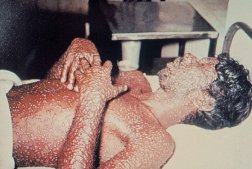Smallpox Fact Sheet
|
Smallpox is caused by the double-stranded DNA orthopoxviruses Variola major and Variola minor. The virus no longer occurs naturally. Due to an aggressive immunization program by the World Health Organization and its inability to survive for more than a week outside of its only host, humans, Variola was declared eradicated in 1980. The two known stock of the virus are at the U.S. Center for Disease Control and Prevention in Atlanta and the State Research Center of Virology and Biotechnology in Koltsovo, Russia. Rumors are that other countries may have retained their stock of smallpox and the Russian stock may have been compromised. Delivery: The smallpox virus can infect humans through inhalation, ingestion, or injection. A smallpox attack would likely rely on victims inhaling Variola via an aerosol or through an infectious individual deliberately infected with the virus. Clothing, blankets, and other such material can harbor the virus for up to a week. Infection with Variola could be accomplished with as little as 10-100 viral particles. Production: Two noted production methods include incubation inside the embryos of chicken eggs and culturing the virus with cells susceptible to infection. Ideally, Variola exists only in secure Biosafety Level-4 labs of the two facilities mentioned above. Historic Use: Some health experts believe that smallpox is responsible for more deaths than all other infectious diseases combined. Beginning in the 1600s, the Native American population of North and South America was exposed to Variola, carried by Europeans. Infections carried a 50% mortality rate. Researchers in the Soviet Union from 1980 until the mid 1990s reportedly developed a strain of Variola as a potent bioweapon, capable of causing illness within two days instead of the average 12 days. |
Effects: Flu-like symptoms, including headache, fever, and fatigue, usually first occur 12 days after exposure. The infected person is also contagious at this stage. Within the next 4 days, the initial lesions containing Variola appear and spread to the arms, torso, and legs. Over the next two weeks, the virus continues to damage the body, particularly the immune and circulatory systems. When the last rash has scabbed over and
Treatment: The vaccine used to eradicate Variola, routinely used in the U.S. until 1972, prevents infections for an undetermined amount of time. It can also prevent or lessen smallpox if administered within four days of exposure. Mild to life-threatening risks are associated with the vaccine. No antivirals are available for unvaccinated individuals who contract the virus. After the symptoms develop, medications and intravenous fluid can be administered to make the patient more comfortable. Antibiotics can reduce potential secondary bacterial infections. |
|||||
(Sources: CDC, U.S. Army, WHO) |
||||||



